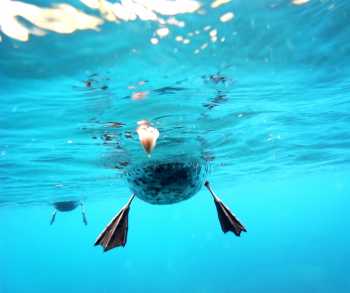Albatrosses and petrels are creatures of three worlds: land, air and sea. We usually see them on land, while at their breeding sites, and in the air - flying over the ocean from a shipor perhaps through a telescope set up on a stormy headland. Less commonly do we see them in their third great habitat: from within the waters of the seas where they obtain their livelihood.
The photograph shown here is of a curious Northern Giant Petrel Macronectes halli, with its distinctive reddish bill tip, taken in Ship's Cove, Marion Island in April 2011 by maritime archaeologist Jaco Boshoff of Iziko Museums of South Africa's Department of Cultural History. Jaco was diving on the wreck of the Solglimt, a Norwegian sealer that was purposefully run aground on the sub-Antarctic island in 1908 after being holed on an uncharted inshore rock, now known as the Solglimt Blinders.

A Northern Giant Petrel takes an underwater look at Marion Island
Photograph by Jaco Boshoff
Curious giant petrels regularly swam up to Jaco and his two diving companions, presumably to see if anything edible was in the offing. Nothing ever was, but Jaco still managed to look up on one occasion and capture a photograph that suggests a little what it is like to be a sea creature on the receiving end of a formidable beak.
With thanks to Jaco Boshoff for the use of his photograph.
John Cooper, ACAP Information Officer, 25 April 2012

 Français
Français  English
English  Español
Español